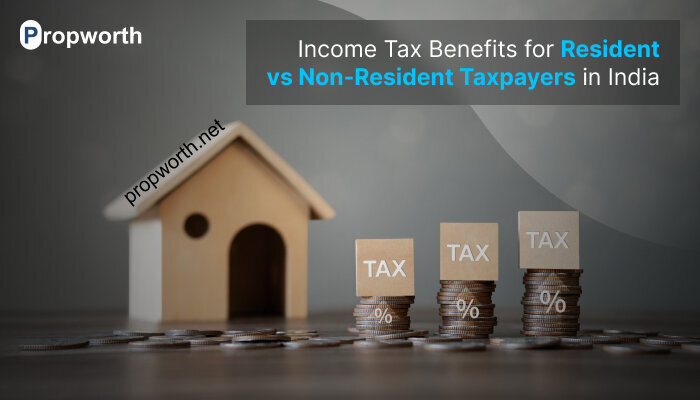India’s tax system is designed with a variety of provisions that take into account the residency status of taxpayers. Whether you are a resident or a non-resident in India, your tax liabilities and the benefits you can claim will vary significantly. This article provides an in-depth comparison of income tax benefits available to resident and non-resident taxpayers in India, highlighting the key differences and implications.
Understanding Residence Status for Tax Purposes
Before delving into the specific tax benefits, it’s important to understand what defines a resident versus a non-resident taxpayer in India. The Income Tax Act of 1961 sets the criteria for determining a person’s residency status for tax purposes.
- Resident: An individual is considered a resident in India if they meet any of the following conditions:
- They are in India for 182 days or more during the financial year.
- They are in India for 60 days or more during the financial year and 365 days or more during the preceding four years.
- Non-Resident (NRI): An individual who does not meet the above conditions is classified as a non-resident.
Additionally, there is a sub-category called Resident but Not Ordinarily Resident (RNOR), which applies to residents who do not meet certain criteria related to their previous residency status in India. RNORs are treated differently in certain tax provisions, but for simplicity, this article focuses on residents and non-residents.
Tax Exemption Limits: Age-Based Differentiation
One of the primary distinctions in tax benefits between residents and non-residents relates to the basic tax exemption limits. These limits vary significantly based on the taxpayer’s age if they are a resident, but remain uniform for non-residents.
- Residents:
- Individuals below 60 years of age are exempt from tax on income up to ₹2.5 lakh per annum.
- Senior citizens (aged 60-80) have a higher exemption limit of ₹3 lakh.
- Super senior citizens (aged 80 and above) enjoy an exemption limit of ₹5 lakh.
- These varying exemption limits apply under the old tax regime.
- Non-Residents:
- Regardless of age, non-residents have a uniform basic exemption limit of ₹2.5 lakh under the old tax regime.
- For those opting for the new tax regime, the basic exemption limit is ₹3 lakh, irrespective of whether the taxpayer is a resident or non-resident.
This age-based differentiation provides significant tax relief for senior resident taxpayers, a benefit not extended to non-residents.
Deductions: Section 80TTB vs. Section 80TTA
Deductions under Sections 80TTB and 80TTA of the Income Tax Act highlight another area where residents, particularly senior citizens, have an advantage over non-residents.
- Section 80TTB:
- Applicable to senior citizens who are residents of India, this section allows a deduction of up to ₹50,000 on interest income earned from banks, post offices, and cooperative banks.
- This benefit is available only under the old tax regime and significantly reduces the taxable income for senior resident taxpayers.
- Section 80TTA:
- Non-residents and residents below 60 years of age can claim a deduction of up to ₹10,000 on interest income from savings accounts with banks, post offices, or cooperative banks under the old tax regime.
- Senior non-residents, however, do not enjoy the higher deduction available under Section 80TTB, limiting their tax-saving opportunities.
The disparity in deductions under these sections underscores the additional tax benefits provided to resident senior citizens, especially those who depend heavily on interest income.
Rebate Under Section 87A
Section 87A offers a rebate on tax liability for individuals whose taxable income falls below a certain threshold. However, this rebate is restricted to residents only, creating a clear distinction between the tax benefits available to residents versus non-residents.
- Residents:
- Under the old tax regime, residents with a taxable income of up to ₹5 lakh can avail a rebate of up to ₹12,500.
- Under the new tax regime, this rebate is increased to ₹25,000 for those with taxable income up to ₹7 lakh.
- This rebate can significantly reduce or even eliminate the tax liability for low-income resident taxpayers.
- Non-Residents:
- Non-residents are not eligible for the rebate under Section 87A in either tax regime.
- This exclusion means that non-residents must pay taxes according to the applicable slab rates without the benefit of this rebate.
The unavailability of the Section 87A rebate for non-residents often leads to higher tax liabilities, particularly for those with lower incomes.
Setting Off Capital Gains Against Basic Exemptions
The treatment of capital gains is another area where residents and non-residents are treated differently. Specifically, the ability to offset capital gains against shortfalls in the basic exemption limit is a benefit exclusive to resident taxpayers.
- Residents:
- If a resident taxpayer’s income (excluding capital gains) is below the basic exemption limit, they can offset this shortfall against their capital gains.
- This provision is particularly beneficial when the capital gains are taxed at special rates, as it can significantly reduce the taxable amount.
- Non-Residents:
- Non-residents do not have the option to offset capital gains against the basic exemption shortfall.
- This results in higher tax liabilities for non-residents who earn income primarily from capital gains.
Deductions for Physical Disability: Section 80U
Section 80U of the Income Tax Act allows for deductions based on the taxpayer’s physical disability. However, this deduction is only available to resident taxpayers.
- Residents:
- A resident individual with a disability can claim a deduction of ₹75,000 for general disability and ₹1,25,000 for severe disability under the old tax regime.
- This deduction helps in significantly lowering the tax burden for residents with disabilities.
- Non-Residents:
- Non-residents are not eligible for deductions under Section 80U.
- This exclusion limits the tax relief available to non-residents who may face similar challenges.
TDS Provisions on Property Sales and Dividends
The provisions for Tax Deducted at Source (TDS) further differentiate the tax obligations of resident and non-resident taxpayers, particularly concerning the sale of immovable property and dividends.
- Property Sales:
- Residents: When a resident sells an immovable property, the buyer is required to deduct 1% TDS on the sale consideration if it exceeds ₹50 lakh.
- Non-Residents: If the seller is a non-resident, the TDS rate is significantly higher—12.50% for properties held for more than two years or 30% of the taxable income from the sale. Moreover, non-residents do not benefit from the threshold of ₹50 lakh; TDS is deducted from the first rupee.
- Dividends:
- Residents: Resident taxpayers can apply to receive dividends without TDS if their total tax liability is expected to be nil.
- Non-Residents: Non-residents do not have this option, as dividends are taxed at a special flat rate of 20%.
These TDS provisions illustrate the more stringent tax collection measures applied to non-residents, reflecting the government’s approach to ensuring tax compliance among non-resident property owners and investors.
Indexation Benefits for Long-Term Capital Gains
The treatment of long-term capital gains, particularly regarding indexation benefits, is another area where residents have an advantage over non-residents.
- Residents:
- Following the budget proposal on July 23, 2024, resident taxpayers have the option to choose between paying a reduced long-term capital gains tax rate of 12.50% without indexation benefits or the standard 20% with indexation for properties acquired before the budget date.
- This flexibility allows residents to optimize their tax liabilities based on their individual circumstances.
- Non-Residents:
- Non-residents do not have this option and must pay the standard long-term capital gains tax without the benefit of indexation.
- This restriction increases the tax burden on non-resident taxpayers who sell long-term assets.
Conclusion
The Indian tax system offers a variety of benefits to resident taxpayers that are not extended to non-residents. These include higher tax exemption limits for senior citizens, additional deductions, rebates under Section 87A and more favorable treatment of capital gains and TDS on property sales. Non-residents, on the other hand, face higher tax rates, stricter TDS provisions, and limited access to certain deductions and exemptions.
For non-residents, understanding these differences is crucial for effective tax planning. Engaging with a qualified tax advisor who understands the intricacies of the Indian tax system can help non-residents navigate these complexities and minimize their tax liabilities.
By being aware of the specific benefits available to residents versus non-residents, taxpayers can make informed decisions, optimize their tax filings, and ensure compliance with Indian tax laws.
Article Source: livemint
Frequently Asked Questions (FAQs)
1. What is the basic tax exemption limit for resident taxpayers in India?
- The basic exemption limit for resident taxpayers varies by age: ₹2.5 lakh for those below 60, ₹3 lakh for senior citizens (60-80 years), and ₹5 lakh for super senior citizens (above 80 years) under the old tax regime.
2. Do non-resident taxpayers get any age-based tax exemptions in India?
- No, non-resident taxpayers have a uniform basic exemption limit of ₹2.5 lakh under the old tax regime, regardless of age. Under the new tax regime, the exemption limit is ₹3 lakh, the same for all individuals.
3. Are non-residents eligible for the rebate under Section 87A?
- No, the rebate under Section 87A, which provides tax relief for individuals with taxable income below certain thresholds, is available only to resident taxpayers in India.
4. Can non-residents claim deductions under Section 80TTB?
- No, Section 80TTB, which allows a higher deduction on interest income for senior citizens, is applicable only to resident taxpayers. Non-residents can claim deductions under Section 80TTA, but the limit is lower.
5. How does the TDS rate differ for residents and non-residents when selling property in India?
- Residents are subject to a 1% TDS on property sales exceeding ₹50 lakh. Non-residents face a much higher TDS rate of 12.50% for long-term property holdings and 30% for short-term, with no minimum threshold for the TDS deduction.
6. Are there any tax deductions available specifically for residents with disabilities?
- Yes, resident taxpayers with disabilities can claim deductions under Section 80U, which is not available to non-residents. The deduction is ₹75,000 for general disability and ₹1,25,000 for severe disability under the old tax regime.
Related Post









